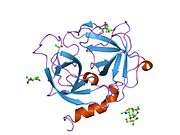Azurocidin 1
| View/Edit Human | |||
Azurocidin also known as cationic antimicrobial protein CAP37 or heparin-binding protein (HBP) is a protein that in humans is encoded by the AZU1 gene.[2][3]
Function
Azurophil granules, specialized lysosomes of the neutrophil, contain at least 10 proteins implicated in the killing of microorganisms. The protein encoded by this gene is an azurophil granule antibiotic protein, with monocyte chemotactic and antibacterial activity. It is also an important multifunctional inflammatory mediator. This encoded protein is a member of the serine protease gene family but it is not a serine proteinase, because the active site serine and histidine residues are replaced. The genes encoding this protein, neutrophil elastase 2, and proteinase 3 are in a cluster located at chromosome 19pter. All 3 genes are expressed coordinately and their protein products are packaged together into azurophil granules during neutrophil differentiation.[3]
Clinical significance
In patients with fever, high plasma levels of HBP indicates that the patient is at high risk of developing sepsis with circulatory collapse.[4]
References
- ↑ "Human PubMed Reference:".
- ↑ Morgan JG, Sukiennicki T, Pereira HA, Spitznagel JK, Guerra ME, Larrick JW (Nov 1991). "Cloning of the cDNA for the serine protease homolog CAP37/azurocidin, a microbicidal and chemotactic protein from human granulocytes". J Immunol. 147 (9): 3210–4. PMID 1919011.
- 1 2 "Entrez Gene: AZU1 azurocidin 1 (cationic antimicrobial protein 37)".
- ↑ Linder A, Christensson B, Herwald H, Björck L, Akesson P (October 2009). "Heparin-binding protein: an early marker of circulatory failure in sepsis". Clin. Infect. Dis. 49 (7): 1044–50. doi:10.1086/605563. PMID 19725785.
Further reading
- Morgan JG, Pereira HA, Sukiennicki T, et al. (1992). "Human neutrophil granule cationic protein CAP37 is a specific macrophage chemotaxin that shares homology with inflammatory proteinases.". Adv. Exp. Med. Biol. 305: 89–96. doi:10.1007/978-1-4684-6009-4_11. PMID 1755383.
- Watorek W (2004). "Azurocidin -- inactive serine proteinase homolog acting as a multifunctional inflammatory mediator.". Acta Biochim. Pol. 50 (3): 743–52. PMID 14515154.
- Zimmer M, Medcalf RL, Fink TM, et al. (1992). "Three human elastase-like genes coordinately expressed in the myelomonocyte lineage are organized as a single genetic locus on 19pter.". Proc. Natl. Acad. Sci. U.S.A. 89 (17): 8215–9. doi:10.1073/pnas.89.17.8215. PMC 49888
 . PMID 1518849.
. PMID 1518849. - Green BG, Weston H, Ashe BM, et al. (1991). "PMN elastases: a comparison of the specificity of human isozymes and the enzyme from other species toward substrates and inhibitors.". Arch. Biochem. Biophys. 286 (1): 284–92. doi:10.1016/0003-9861(91)90042-H. PMID 1897955.
- Flodgaard H, Ostergaard E, Bayne S, et al. (1991). "Covalent structure of two novel neutrophile leucocyte-derived proteins of porcine and human origin. Neutrophile elastase homologues with strong monocyte and fibroblast chemotactic activities.". Eur. J. Biochem. 197 (2): 535–47. doi:10.1111/j.1432-1033.1991.tb15942.x. PMID 2026172.
- Almeida RP, Melchior M, Campanelli D, et al. (1991). "Complementary DNA sequence of human neutrophil azurocidin, an antibiotic with extensive homology to serine proteases.". Biochem. Biophys. Res. Commun. 177 (2): 688–95. doi:10.1016/0006-291X(91)91843-2. PMID 2049091.
- Pohl J, Pereira HA, Martin NM, Spitznagel JK (1990). "Amino acid sequence of CAP37, a human neutrophil granule-derived antibacterial and monocyte-specific chemotactic glycoprotein structurally similar to neutrophil elastase.". FEBS Lett. 272 (1–2): 200–4. doi:10.1016/0014-5793(90)80484-Z. PMID 2226832.
- Campanelli D, Detmers PA, Nathan CF, Gabay JE (1990). "Azurocidin and a homologous serine protease from neutrophils. Differential antimicrobial and proteolytic properties". J. Clin. Invest. 85 (3): 904–15. doi:10.1172/JCI114518. PMC 296509
 . PMID 2312733.
. PMID 2312733. - Pereira HA, Shafer WM, Pohl J, et al. (1990). "CAP37, a human neutrophil-derived chemotactic factor with monocyte specific activity". J. Clin. Invest. 85 (5): 1468–76. doi:10.1172/JCI114593. PMC 296594
 . PMID 2332502.
. PMID 2332502. - Wilde CG, Snable JL, Griffith JE, Scott RW (1990). "Characterization of two azurphil granule proteases with active-site homology to neutrophil elastase". J. Biol. Chem. 265 (4): 2038–41. PMID 2404977.
- Pereira HA, Spitznagel JK, Pohl J, et al. (1990). "CAP 37, a 37 kD human neutrophil granule cationic protein shares homology with inflammatory proteinases". Life Sci. 46 (3): 189–96. doi:10.1016/0024-3205(90)90104-Y. PMID 2406527.
- Gabay JE, Scott RW, Campanelli D, et al. (1989). "Antibiotic proteins of human polymorphonuclear leukocytes". Proc. Natl. Acad. Sci. U.S.A. 86 (14): 5610–4. doi:10.1073/pnas.86.14.5610. PMC 297672
 . PMID 2501794.
. PMID 2501794. - Pereira HA, Erdem I, Pohl J, Spitznagel JK (1993). "Synthetic bactericidal peptide based on CAP37: a 37-kDa human neutrophil granule-associated cationic antimicrobial protein chemotactic for monocytes". Proc. Natl. Acad. Sci. U.S.A. 90 (10): 4733–7. doi:10.1073/pnas.90.10.4733. PMC 46587
 . PMID 8506327.
. PMID 8506327. - Chertov O, Michiel DF, Xu L, et al. (1996). "Identification of defensin-1, defensin-2, and CAP37/azurocidin as T-cell chemoattractant proteins released from interleukin-8-stimulated neutrophils". J. Biol. Chem. 271 (6): 2935–40. doi:10.1074/jbc.271.6.2935. PMID 8621683.
- Iversen LF, Kastrup JS, Bjørn SE, et al. (1997). "Structure of HBP, a multifunctional protein with a serine proteinase fold". Nat. Struct. Biol. 4 (4): 265–8. doi:10.1038/nsb0497-265. PMID 9095193.
- Karlsen S, Iversen LF, Larsen IK, et al. (1998). "Atomic resolution structure of human HBP/CAP37/azurocidin". Acta Crystallogr. D. 54 (Pt 4): 598–609. doi:10.1107/S0907444997016193. PMID 9761855.
- Olofsson AM, Vestberg M, Herwald H, et al. (1999). "Heparin-binding protein targeted to mitochondrial compartments protects endothelial cells from apoptosis". J. Clin. Invest. 104 (7): 885–94. doi:10.1172/JCI6671. PMC 408551
 . PMID 10510329.
. PMID 10510329. - Lindmark A, Garwicz D, Rasmussen PB, et al. (1999). "Characterization of the biosynthesis, processing, and sorting of human HBP/CAP37/azurocidin". J. Leukoc. Biol. 66 (4): 634–43. PMID 10534120.





